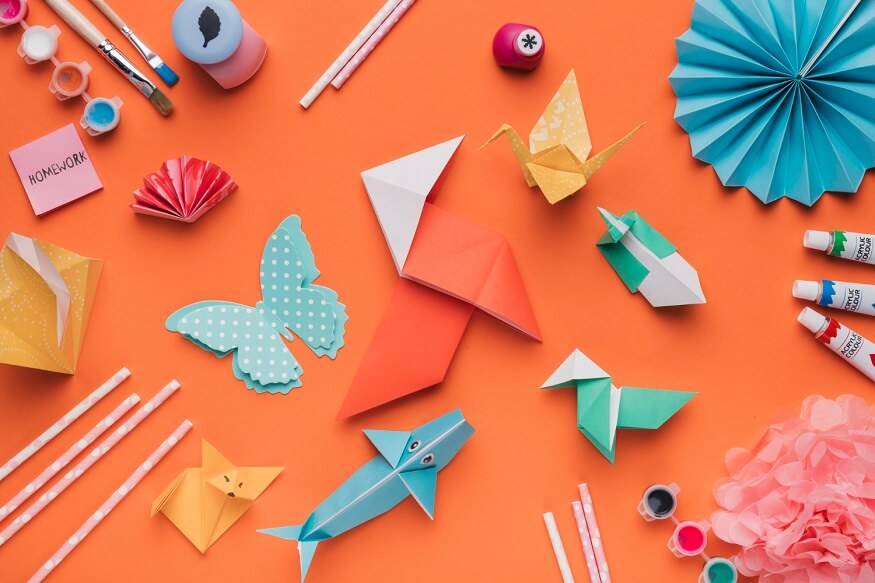Origami is a traditional Japanese art of paper folding which has gained significant popularity across the world. It is an art form that is used to create various shapes by folding a square piece of paper. The term origami is derived from the Japanese words “ori” meaning folded and “kami” meaning paper. The art form has a rich history and through its various styles has continued to captivate people worldwide.
Also Read: Tips for engaging children in arts and music
Origami Meaning
Origami is a form of paper art that involves creating intricate shapes and models using only paper. This popular traditional Japanese art form has been around for centuries. The uniqueness of this art form is that it requires no cuts or glue to hold the folds in place.
Origami History
The history of origami can be traced back to 6th century Japan when paper was first introduced. It was initially used for ceremonial purposes such as wrapping gifts and money during religious ceremonies. By the 17th century, the art form had spread throughout Japan and it became a form of recreation. During this period, paper with different colours and textures was introduced, leading to even more creative designs.
Different Styles or Types of Origami
Origami only uses folding and creasing techniques. These include pleat folds, mountain folds, reverse folds, sink folds, squash folds, and petal folds. Here are five popular styles worth knowing if you are interested in mastering this art form.
- Traditional Origami:
- Modular Origami:
- Wet-folding Origami:
- Tessellation Origami:
- Kirigami:
The traditional origami models have no known creators. This style adheres to conventional paper folding methods without the use of scissors or glue. Traditional origami adheres to a set of rules focussing on geometric patterns and symmetrical designs. The patterns included in traditional origami include flowers, animals, and other objects from nature.
This style involves the folding of multiple sheets of paper and assembling them to create complex designs that are not possible with a single sheet of paper. A variety of patterns can be created using modular origami, including spikey balls, cubes, prisms, boxes, stars, pyramids, tetrahedra, architectural structures and more.
This technique was developed by Akira Yoshizawa, a leading origami practitioner. This style requires dampening the paper with water before folding so that one can easily create designs with more natural curves, and add more depth to the finished product. This technique is most often used by professional folders for non-geometric origami designs such as animals, humans and legendary creatures.
This style creates a repetitive pattern by folding a single sheet of paper. It involves precise folding, often requiring both sides of the paper to be visible. The core property of a tessellation is that of a mosaic where a fold or a group of folds is repeated again and again, in all directions.
Kirigami is a variation of origami. This style involves both folding and cutting the paper to create three-dimensional designs and movement. It is also the only style that allows for the use of scissors in origami but does not typically use glue. Symmetry is an important consideration in kirigami. The most commonly made design using kirigami is pop-up greeting cards.
Also Read: Origami paper buying guide
Origami Facts
Origami is not just another creative art form. Here are some interesting facts to know about this art form:
The biggest origami sculpture ever created measured 51 feet tall and was a replica of an Ulmus Parvifolia tree, which took six months to design and eight hours to fold and construct.
Origami designs were originally considered too common to be displayed in museums or galleries, but modern origami art has changed that.
The smallest origami paper crane ever folded measured 0.1cm, while the largest weighed 500 kg and took fifteen people to carry.
The art form is so well-loved that it now has an annual celebration, Origami Day, celebrated worldwide on the 11th of November.
Ancient Japanese lore said that cranes are a symbol of good fortune and longevity and if one folds one thousand paper cranes, they will be granted a wish.
Origami is found to be good for health and healing. It has been used in art therapy and occupational therapy and helps improve memory, non-verbal thinking, concentration, hand-eye coordination and more.
NASA uses origami to test theories using scaled-down models to ensure their designs are viable.
Principles of origami have been used in the fields of engineering and robotics. Scientists observe and study origami’s folding techniques to develop structures that can be folded and unfolded. This has been particularly useful in the area of medical devices.
Also Read: 15 Hands- On Math Activities for Preschoolers
Conclusion
Origami is more than simply folding paper. It is an art form with an incredibly rich and fascinating history. From delicate flowers to complex geometric designs, origami has endless possibilities that can be achieved with just a simple piece of paper.
Practising origami requires skill, creativity, and patience. So, pick up a sheet of paper, fold and let your imagination find inspiration in the designs as you embrace the art of origami.









